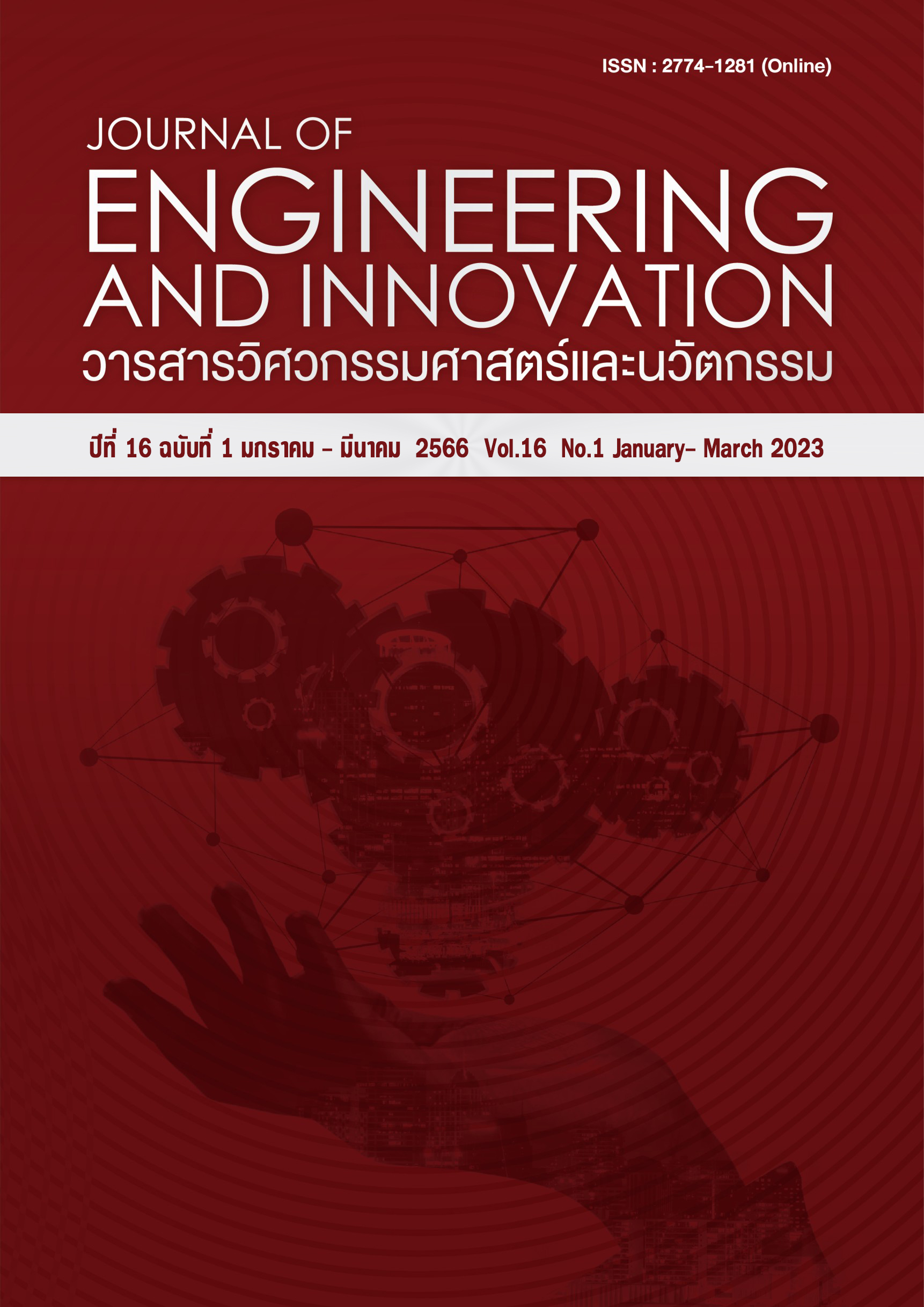CIPP-Const Model for Construction Projects Evaluation
Main Article Content
Abstract
The purposes of this research were to 1) develop a CIPP model for construction project evaluation and 2) test the developed CIPP model for the evaluation of various construction projects. The sample group was those who worked in all five kinds of construction projects. Of these five categories, five people was sampled from each of the three projects. A total of 75 samples participated in this research study. The questionnaire was used as a tool to collect the data. The percentage, mean, standard deviation, the test of validity and reliability, and One-way ANOVA were used for analyzing the collected data. The results reveal that 1) the CIPP model for construction projects evaluation is divided into four parts, i.e. context evaluation, input evaluation, process evaluation and product evaluation; and 2) this CIPP Model is valid (IOC = 0.60 – 1.00) and highly reliable (α=0.840). In other words, it can be applied for evaluating overall five construction project types, i.e. general building, residential building, road and transportation route, water resources and irrigation, and high-rise building, with the similar level of reliability.
Article Details
References
ธเนศ มหัทธนาลัย. แนวโน้มธุรกิจ/อุตสาหกรรม ปี 2564-2566 ธุรกิจรับเหมาก่อสร้าง. แหล่งที่มา: https://www.krungsri.com/th/research/industry/industry-outlook/Construction-Construction-Materials/Construction-Contractors/IO/io-Construction-Contractors-21 [สืบค้นวันที่ 24 เมษายน 2564]
วสันต์ ธีระเจตกูล, ฐาปนัสม์ ดาวแจ้งและ วันเฉลิม คำเจริญ. สาเหตุความล่าช้าในโครงการก่อสร้าง: กรณีศึกษาโครงการอาคารที่พักอาศัย 8 ชั้น. วารสารวิศวกรรมและเทคโนโลยีมหาวิทยาลัยรังสิต. 2559;19(2): 38-46.
สุปรีย์ ศรีสำราญ. EIC SCB แนะอุตสาหกรรมก่อสร้างไทย ควรเตรียมพร้อม 3 ด้าน ในยุคโควิด-19. แหล่งที่มา: https://www.efinancethai.com/LastestNews/LatestNewsMain.aspx?ref=A&id=TXAwS0hFamxLRE09 [สืบค้นวันที่ 24 เมษายน 2564]
เชาว์ อินใย. การประเมินโครงการ. กรุงเทพมหานคร: สำนักพิมพ์จุฬาลงกรณ์มหาวิทยาลัย; 2553.
วีณา วาระกุล. การประเมินผลโครงการสร้างฝายชะลอน้ำขององค์การบริหารส่วนตำบลหัวฝาย อำเภอสูงเม่น จังหวัดแพร่. การค้นคว้าอิสระปริญญารัฐประศาสนศาสตรมหาบัณฑิต, มหาวิทยาลัยราชภัฏลำปาง. 2558.
ประสาท อัมระปาล. การประเมินผลโครงการปรับปรุงทางหลวงหมายเลข 214 ตอนเกษตรวิสัย – ปอหมัน จังหวัดร้อยเอ็ด. วิทยานิพนธ์ศิลปศาสตรมหาบัณฑิต,มหาวิทยาลัยราชภัฏร้อยเอ็ด. 2553.
สมหวัง พิธิยานุวัฒน์ (บรรณาธิการ). รวมบทความทางการประเมินโครงการ. กรุงเทพมหานคร: สำนักพิมพ์จุฬาลงกรณ์มหาวิทยาลัย; 2533.
กิ่งกาญจน์ สิรสุคนธ์. รูบริคหรือรูบริคการให้คะแนน. กรุงเทพมหานคร: สานักวิชาการและมาตรฐานการศึกษา. 2550.
Nitko, Anthony J. Educational Test and Measurement: An Introduction. NY: Harcourt Brace Jovanovich. 1983.
สมศักดิ์ สินธุระเวชญ์. การจัดหลักสูตรของสถานศึกษา. เอกสารประชุมเชิงปฏิบัติการเรื่องการศึกษาขั้นพื้นฐาน การพัฒนาหลักสูตรในศตวรรษที่ 21. วันที่ 22 – 23กรกฎาคม 2542 สาขาวิชาหลักสูตรและการนิเทศ ภาควิชาหลักสูตรและวิธีสอน.มหาวิทยาลัยศิลปากร, 2542. 180-190.
แจ่ม ธาราวร. การบริหารระบบประกันคุณภาพภายในโรงเรียนของผู้บริหารโรงเรียนประถมศึกษาสังกัดสานักงานการประถมศึกษาจังหวัดพระนครศรีอยุธยา. วิทยานิพนธ์ครุศาสตรมหาบัณฑิต, สาขาวิชาบริหารการศึกษา, มหาวิทยาลัยราชภัฏพระนครศรีอยุธยา. 2548.
ประกอบ พอดี. การนำวงจรเดมมิ่งมาใช้ในการปฏิบัติงานของผู้บริหารสถานศึกษา 3 สังกัดสานักงานเขตพื้นที่การศึกษาชลบุรี เขต 1. วิทยานิพนธ์ครุศาสตรมหาบัณฑิต, สาขาวิชาการบริหารการศึกษา, มหาวิทยาลัยราชภัฏกาญจนบุรี. 2549.
ชลิต ชูแสง. การศึกษาปัจจัยที่ส่งผลกระทบต่อความล่าช้าในโครงการก่อสร้างงานสะพานและงานถนน. วิทยานิพนธ์วิศวกรรมศาสตรมหาบัณฑิต, มหาวิทยาลัยเทคโนโลยีพระจอมเกล้าธนบุรี. 2553.
อิทธิชัย ยังบรรเทา. การศึกษาแนวทางการป้องกันและแก้ไขความล่าช้าในงานก่อสร้างอาคารสูง. วิทยานิพนธ์วิศวกรรมศาสตรมหาบัณฑิต, มหาวิทยาลัยเทคโนโลยีพระจอมเกล้าธนบุรี. 2553
Mohamed M. Marzouk, Tarek I. El-Rasas. Analyzing delay causes in Egyptian construction projects. Journal of Advanced Research. 2014; 5: 49-55.
Remon Fayek Aziz. Ranking of delay factors in construction projects after Egyptian revolution. Alexandria Engineering Journal. 2013; 52: 387-406.
Michal Gluszak, Agnieszka Lesniak. Construction delays in clients opinion – multivariate statistical analysis. Procedia Engineering. 2015; 123: 182-189.
Remon F. Aziz, Asmaa A. Abdel-Hakam. Exploring delay causes of road construction projects in Egypt. Alexandria Engineering Journal. 2016; 55: 1,515-1,539.
Tsegay Gebrehiwet, Hanbin Luo. Analysis of Delay Impact on Construction Project Based on RII and Correlation Coefficient: Empirical Study. Procedia Engineering. 2017; 196: 366-374.
Jawad A. Alsuliman. Causes of delay in Saudi public construction projects. Alexandria Engineering Journal. 2019; 58: 801-808.
ณัฐชัย สุนทรพิพิธ. กรณีศึกษาปัจจัยที่มีอิทธิพลต่อความสำเร็จของโครงการก่อสร้างรถไฟฟ้าใต้ดิน. วิทยานิพนธ์วิศวกรรมศาสตรมหาบัณฑิต, มหาวิทยาลัยเทคโนโลยีพระจอมเกล้าธนบุรี. 2546.
อนุศาสตร์ คำหอม. ปัจจัยสู่ความสำเร็จตลอดวงจรอายุสำหรับโครงการก่อสร้างอาคาร. วิทยานิพนธ์วิศวกรรมศาสตรมหาบัณฑิต, มหาวิทยาลัยเทคโนโลยีพระจอมเกล้าธนบุรี. 2549.
Nokulunga Mashwama, Clinton Aigbavboa and Didi Thwala. An Assessment Of The Critical Success factor For The ReductionOf Cost Of Poor Quality In Construction Projects In Swaziland. Procedia Engineering. 2017; 196: 447-453.
ศิริชัย กาญจนวาสี. ทฤษฏีการประเมิน. กรุงเทพมหานคร: สำนักพิมพ์จุฬาลงกรณ์มหาวิทยาลัย; 2536.
Keith S. Taber. The Use of Cronbach’s Alpha When Developing and Reporting Research Instrument in Science Education. Research in Science Education. 2018; 48: 1273-1296
Bonett DG. Sample size requirements for testing and estimating coefficient alpha. Journal of Educational and Behavioral Statistics. 2002; 27(4): 335 – 340.
กัลยา วานิชย์บัญชา และฐิติยา วานิชย์บัญชา. การใช้ SPSS for Windows ในการวิเคราะห์ข้อมูล. พิมพ์ครั้งที่ 29. กรุงเทพมหานคร: โรงพิมพ์สามลดา. 2560.

